A Real-Time Calculation Method to Improve Boiler Safety in Deep Peak Shaving Cases
Abstract
:1. Introduction
2. Model Building
2.1. Project Introduction
2.2. Data Preparation
2.3. Circuit Division
2.4. Calculation Model
2.4.1. Calculation Method for Flue Gas Side Heat Transfer
2.4.2. Fluid Flow and Heat Transfer Model
3. Results and Discussion
3.1. Boiler Physical Model and Operating Parameters
3.2. Heat Load Screening
3.3. Heat Transfer Process Calculation
3.3.1. Flow Resistance Calculation
3.3.2. Calculation of Heat Transfer in the Tube
3.3.3. The Program Performs Calculations
4. Conclusions
- The coupled model was used to numerically simulate the heat transfer and wall temperature distribution of a 1000 MW boiler’s water-cooled wall. The calculated and measured results of the boiler’s smoke temperature distribution and wall temperature distribution under different loads were in good agreement. The true wall temperature of the full screen tube was within 2 °C, and the accuracy of the model was verified.
- We utilized machine learning algorithms based on embedded mechanism models to achieve real-time online visualization prediction of flow temperature, pressure, and wall temperature in pipes at different local overheating positions of water-cooled walls. At the same time, based on the full working condition databases of flue gas and working fluid sides in the furnace and select characteristic variables, we constructed a unit control system based on the 3D distribution of heat load in the furnace to achieve safe and stable operation of the unit at 15–110% rated load.
Author Contributions
Funding
Conflicts of Interest
References
- Zhou, S.; Wang, Y.; Zhou, Y.; Clarke, L.E.; Edmonds, J.A. Roles of wind and solar energy in China’s power sector: Implications of intermittency constraints. Appl. Energy 2018, 213, 22–30. [Google Scholar] [CrossRef]
- Liu, L.; Wang, Z.; Wang, Y.; Wang, J.; Chang, R.; He, G.; Tang, W.; Gao, Z.; Li, J.; Liu, C. Optimizing wind/solar combinations at finer scales to mitigate renewable energy variability in China. Renew. Sustain. Energy Rev. 2020, 132, 110151. [Google Scholar] [CrossRef]
- Henderson, C. Increasing the flexibility of coal-fired power plants. IEA Clean Coal Cent. 2014, 15, 15. [Google Scholar]
- Huang, C.; Zhang, P.; Wang, W.; Huang, Z.; Lv, J.; Liu, J.; Ni, W. The upgradation of coal-fired power generation industry supports China’s energy conservation, emission reduction and carbon neutrality. Therm. Power Gener. 2021, 50, 1–6. [Google Scholar]
- Guo, X.; Zhao, G.; Sun, Z.; Song, B.; Guo, J.; Zhao, Z.; Li, H. Effect of Recirculated Flue Gas on Steam Parameters of 660 MW Double Reheat Boiler. Proc. CSEE 2018, 38, 1101–1110. [Google Scholar]
- Xiong, T.; Yan, X.; Huang, S.; Yu, J.; Huang, Y. Modeling and analysis of supercritical flow instability in parallel channels. Int. J. Heat Mass Transf. 2013, 57, 549–557. [Google Scholar] [CrossRef]
- Shen, Z.; Yang, D.; Wang, S.; Wang, W.; Li, Y. Experimental and numerical analysis of heat transfer to water at supercritical pressures. Int. J. Heat Mass Transf. 2017, 108, 1676–1688. [Google Scholar] [CrossRef]
- Shen, Z.; Yang, D.; Xie, H.; Nie, X.; Liu, W.; Wang, S. Flow and heat transfer characteristics of high-pressure water flowing in a vertical upward smooth tube at low mass flux conditions. Appl. Therm. Eng. 2016, 102, 391–401. [Google Scholar] [CrossRef]
- Liu, P.; Hou, D.; Lin, M.; Kuang, B.; Yang, Y. Stability analysis of parallel-channel systems under supercritical pressure with heat exchanging. Ann. Nucl. Energy 2014, 69, 267–277. [Google Scholar] [CrossRef]
- Wu, X.; Fan, W.; Liu, Y.; Bian, B. Numerical simulation research on the unique thermal deviation in a 1000 MW tower type boiler. Energy 2019, 173, 1006–1020. [Google Scholar] [CrossRef]
- Tan, P.; Fang, Q.; Zhao, S.; Yin, C.; Zhang, C.; Zhao, H.; Chen, G. Causes and mitigation of gas temperature deviation in tangentially fired tower-type boilers. Appl. Therm. Eng. 2018, 139, 135–143. [Google Scholar] [CrossRef]
- Yang, X.; Ingham, D.; Ma, L.; Zhou, H.; Pourkashanian, M. Understanding the ash deposition formation in Zhundong lignite combustion through dynamic CFD modelling analysis. Fuel 2017, 194, 533–543. [Google Scholar] [CrossRef]
- Boyd, R.; Kent, J. Three-dimensional furnace computer modelling. Symp. (Int.) Combust. 1988, 21, 265–274. [Google Scholar] [CrossRef]
- Gao, N.; Jia, X.; Gao, G.; Ma, Z.; Quan, C.; Naqvi, S.R. Modeling and simulation of coupled pyrolysis and gasification of oily sludge in a rotary kiln. Fuel 2020, 279, 118152. [Google Scholar] [CrossRef]
- Starkloff, R.; Alobaid, F.; Karner, K.; Epple, B.; Schmitz, M.; Boehm, F. Development and validation of a dynamic simulation model for a large coal-fired power plant. Appl. Therm. Eng. 2015, 91, 496–506. [Google Scholar] [CrossRef]
- Liu, H.; Wang, Y.; Zhang, W.; Wang, H.; Deng, L.; Che, D. Coupled modeling of combustion and hydrodynamics for a 1000 MW double-reheat tower-type boiler. Fuel 2019, 255, 115722. [Google Scholar] [CrossRef]
- Schuhbauer, C.; Angerer, M.; Spliethoff, H.; Kluger, F.; Tschaffon, H. Coupled simulation of a tangentially hard coal fired 700 C boiler. Fuel 2014, 122, 149–163. [Google Scholar] [CrossRef]
- Laubscher, R.; Rousseau, P. Coupled simulation and validation of a utility-scale pulverized coal-fired boiler radiant final-stage superheater. Therm. Sci. Eng. Prog. 2020, 18, 100512. [Google Scholar] [CrossRef]
- Chen, T.; Zhang, Y.-j.; Liao, M.-r.; Wang, W.-z. Coupled modeling of combustion and hydrodynamics for a coal-fired supercritical boiler. Fuel 2019, 240, 49–56. [Google Scholar] [CrossRef]
- Guo, X.; Xia, L.; Zhao, G.; Wei, G.; Wang, Y.; Yin, Y.; Guo, J.; Ren, X. Steam temperature characteristics in boiler water wall tubes based on furnace CFD and hydrodynamic coupling model. Energies 2022, 15, 4745. [Google Scholar] [CrossRef]
- Laubscher, R.; Rousseau, P. Numerical investigation on the impact of variable particle radiation properties on the heat transfer in high ash pulverized coal boiler through co-simulation. Energy 2020, 195, 117006. [Google Scholar] [CrossRef]
- Rousseau, P.G.; Gwebu, E.Z. Modelling of a superheater heat exchanger with complex flow arrangement including flow and temperature maldistribution. Heat Transf. Eng. 2019, 40, 862–878. [Google Scholar] [CrossRef]
- Liu, H.; Zhang, W.; Wang, H.; Zhang, Y.; Deng, L.; Che, D. Coupled combustion and hydrodynamics simulation of a 1000 MW double-reheat boiler with different FGR positions. Fuel 2020, 261, 116427. [Google Scholar] [CrossRef]
- Modliński, N.; Szczepanek, K.; Nabagło, D.; Madejski, P.; Modliński, Z. Mathematical procedure for predicting tube metal temperature in the second stage reheater of the operating flexibly steam boiler. Appl. Therm. Eng. 2019, 146, 854–865. [Google Scholar] [CrossRef]
- Ge, X.; Zhang, Z.; Fan, H.; Shang, X.; Dong, J. Study on the effect of flame offset and flow deviation on wall water tube temperature of 1000 mw ultra-supercritical boiler: Zhongguo Dianji Gongcheng Xuebao. Proc. Chin. Soc. Electr. Eng. 2018, 38, 2348–2357. [Google Scholar]
- Lv, Z.; Xiong, X.; Tan, H.; Wang, X.; Liu, X.; ur Rahman, Z. Experimental investigation on NO emission and burnout characteristics of high-temperature char under the improved preheating combustion technology. Fuel 2022, 313, 122662. [Google Scholar] [CrossRef]
- Zhao, S.; Hui, S.; Liang, L.; Zhou, Q.; Zhao, Q.; Li, N.; Tan, H.; Xu, T. Effect of the momentum flux ratio of vertical to horizontal component on coal combustion in an arch-fired furnace with upper furnace over-fire air. Exp. Therm. Fluid Sci. 2013, 45, 180–186. [Google Scholar] [CrossRef]
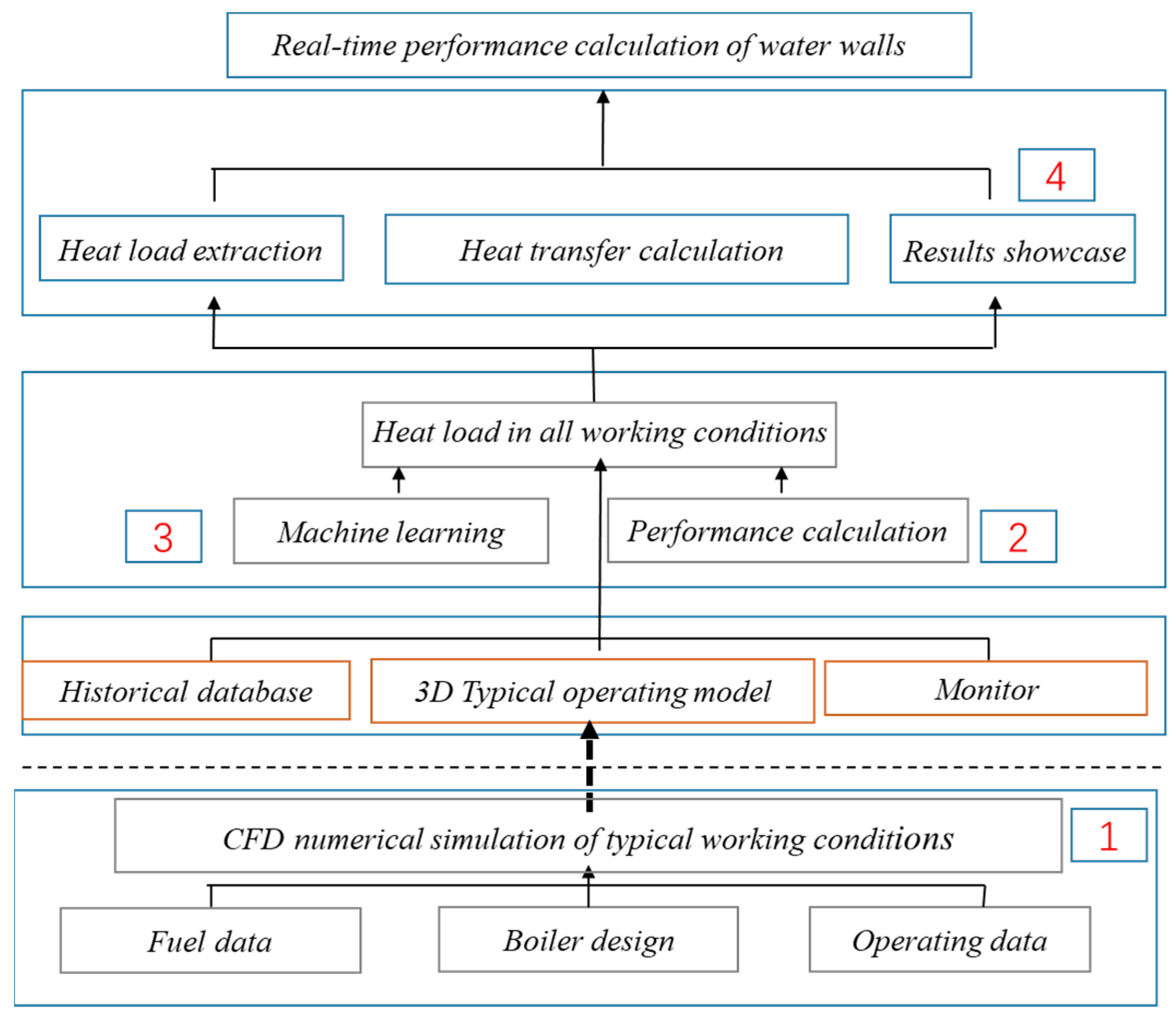
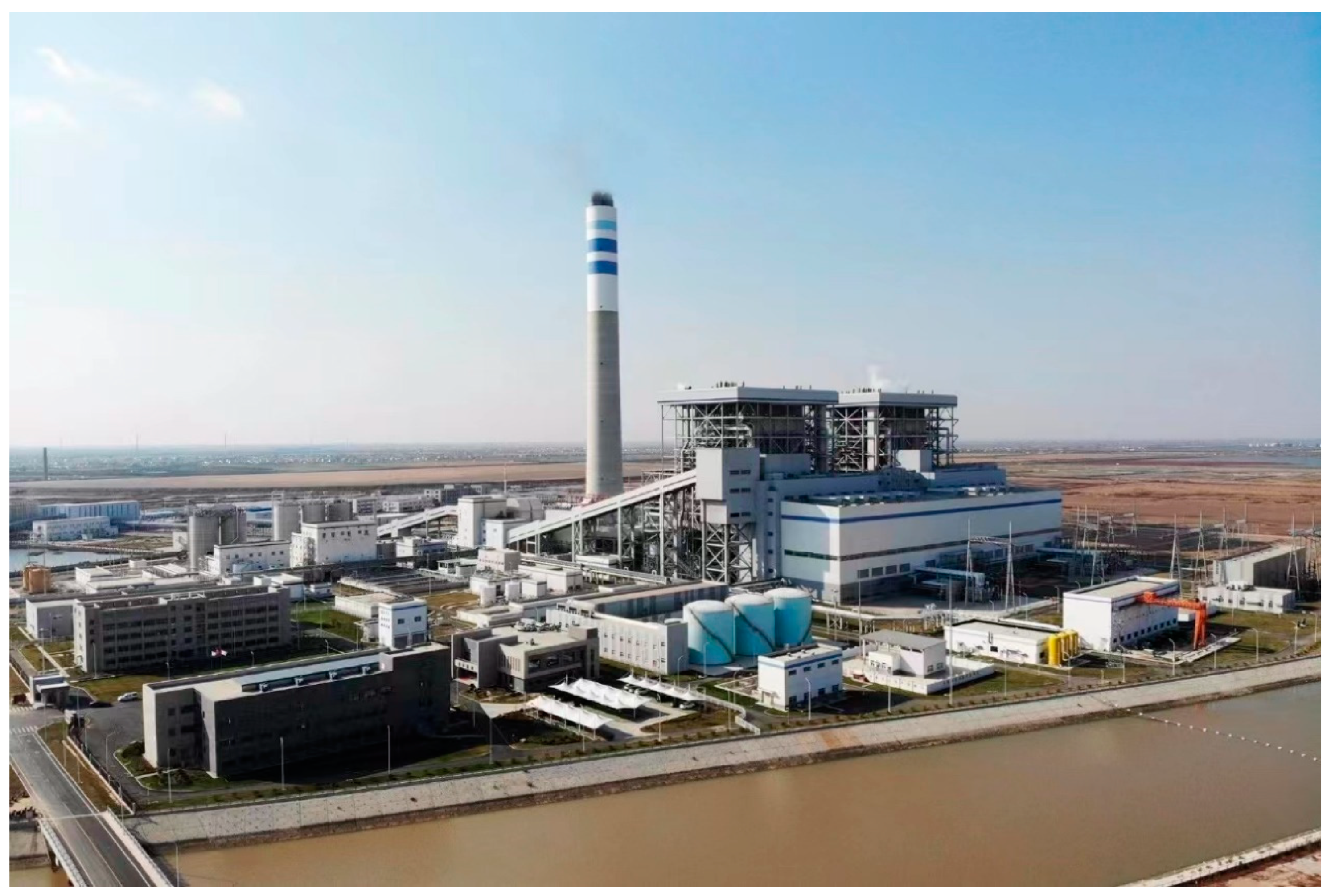

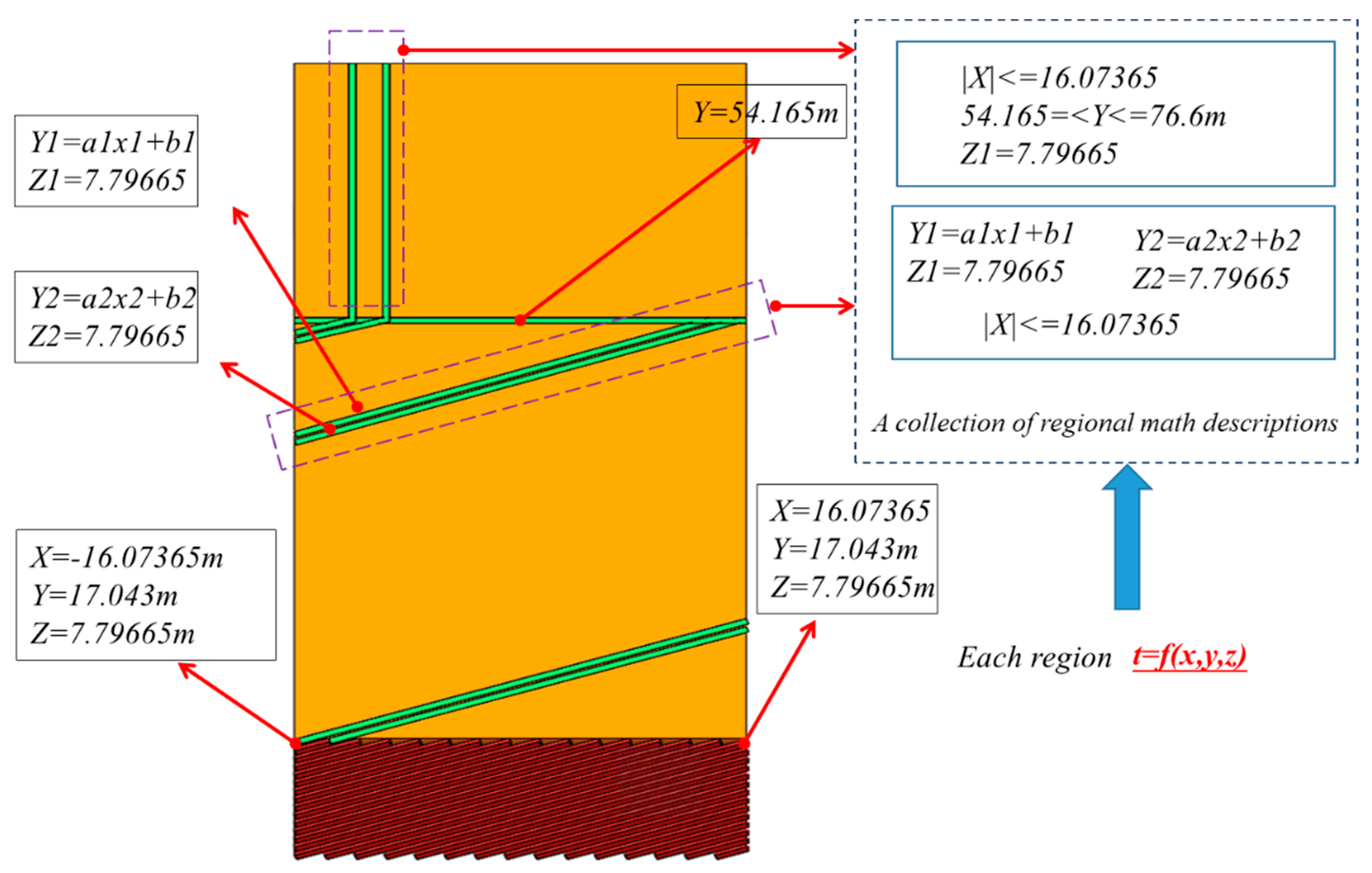

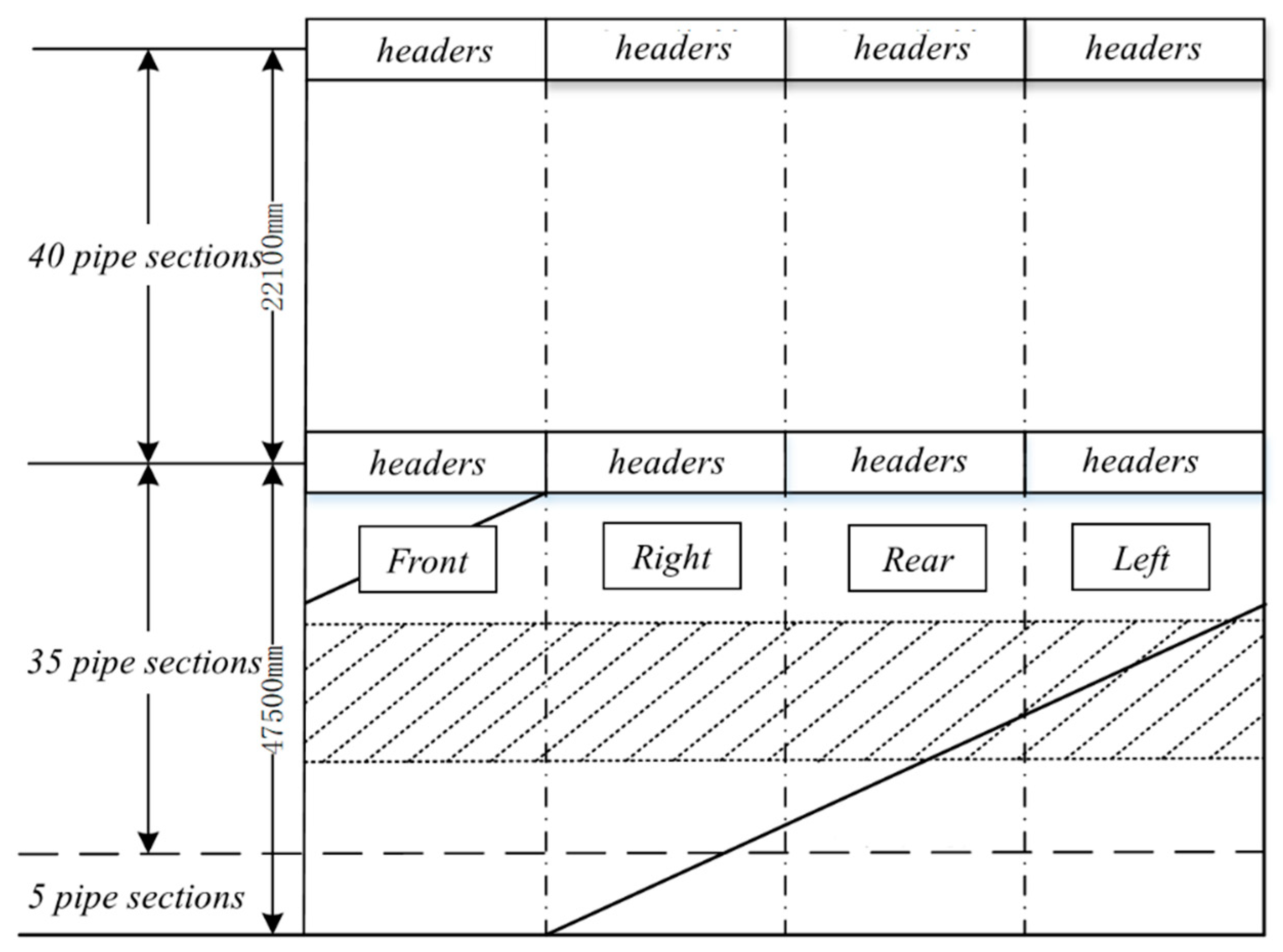
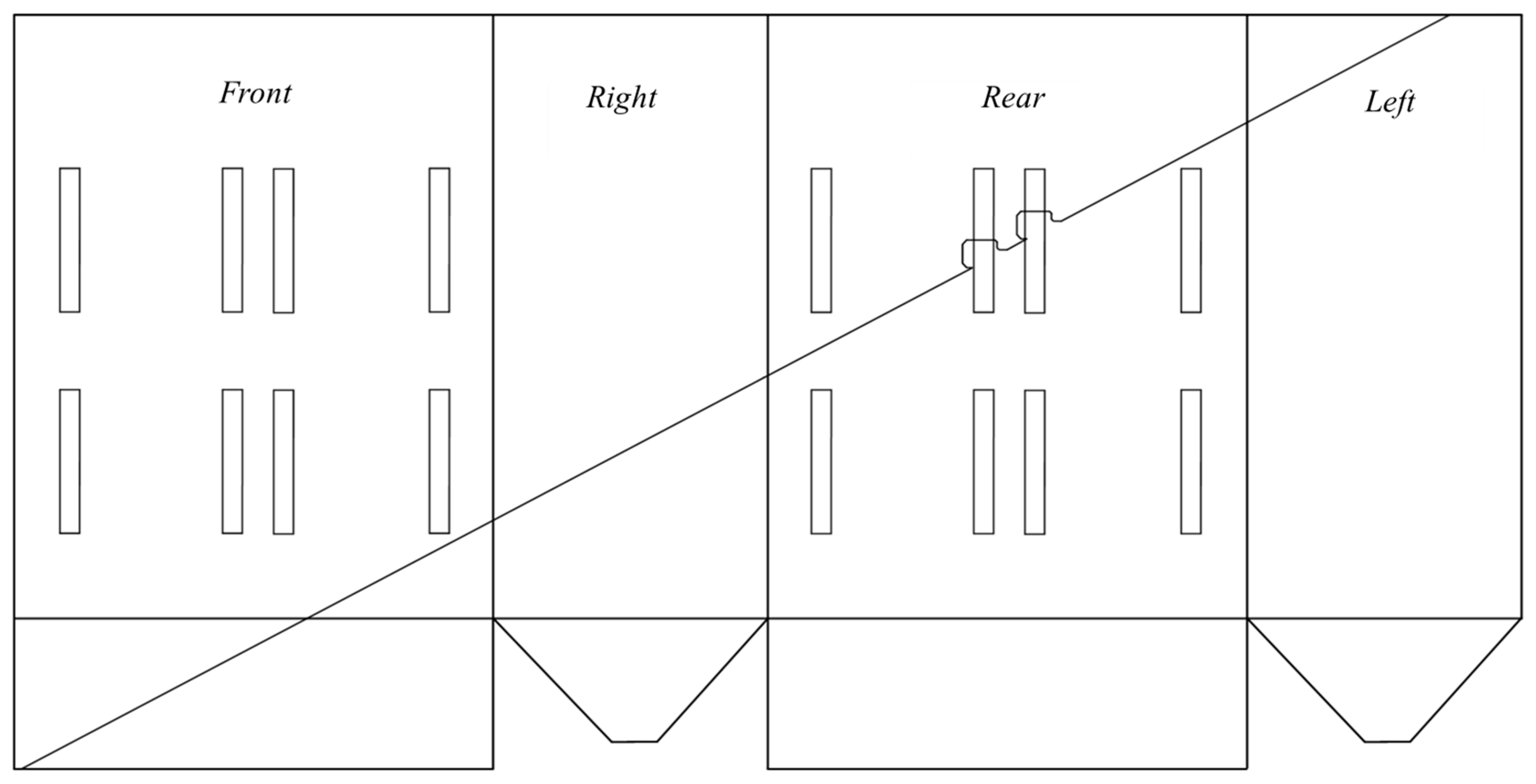
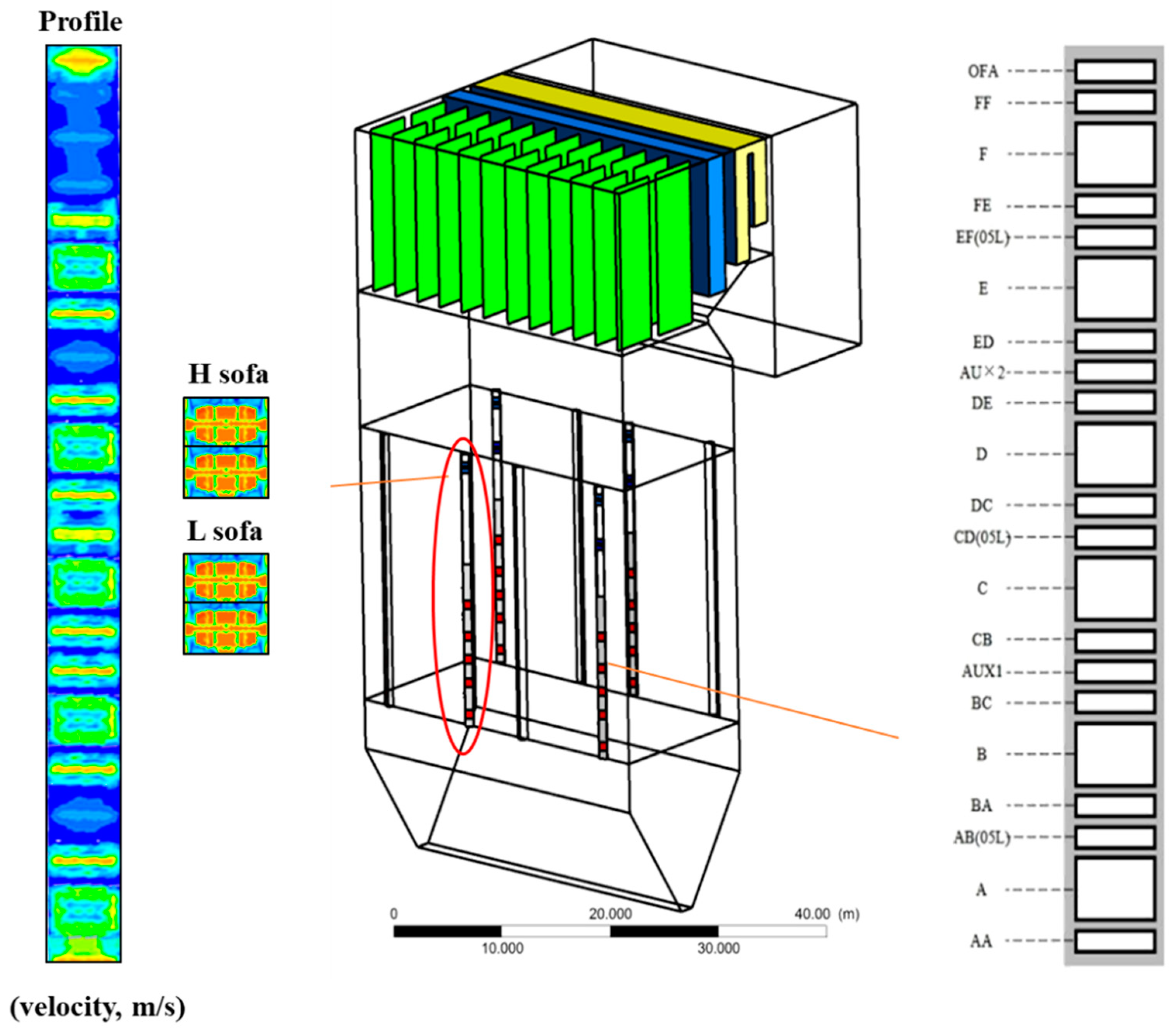
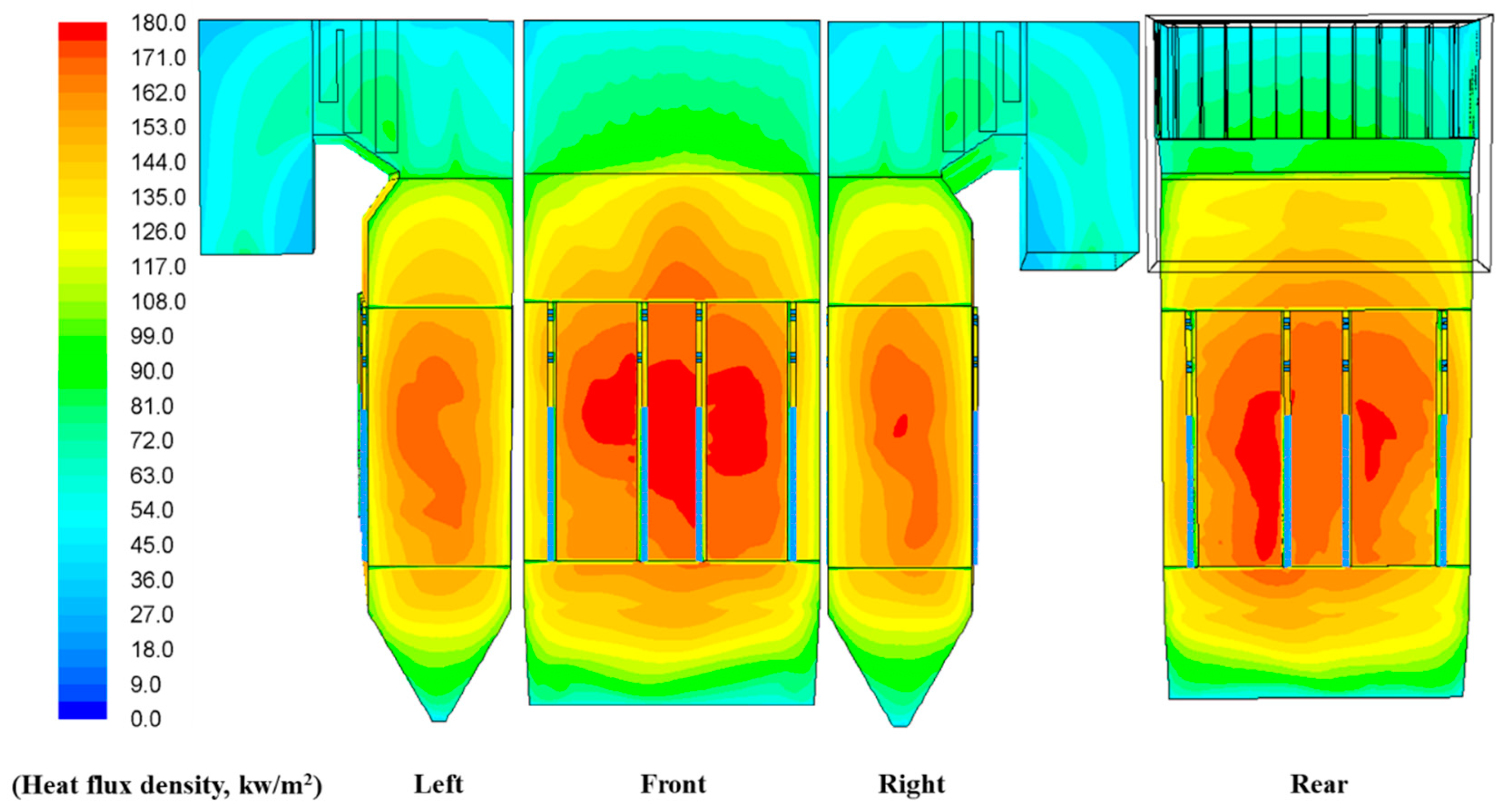

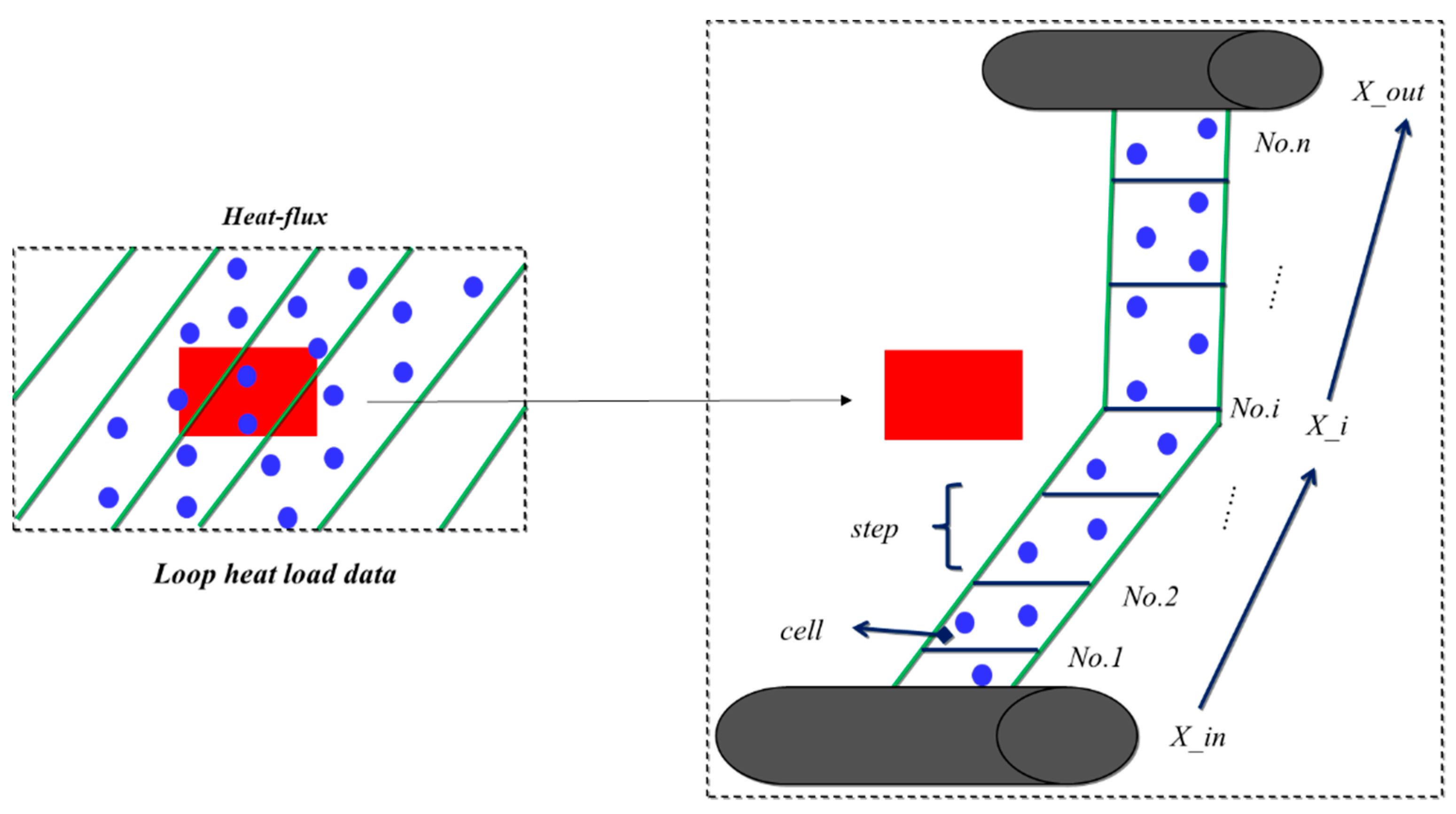
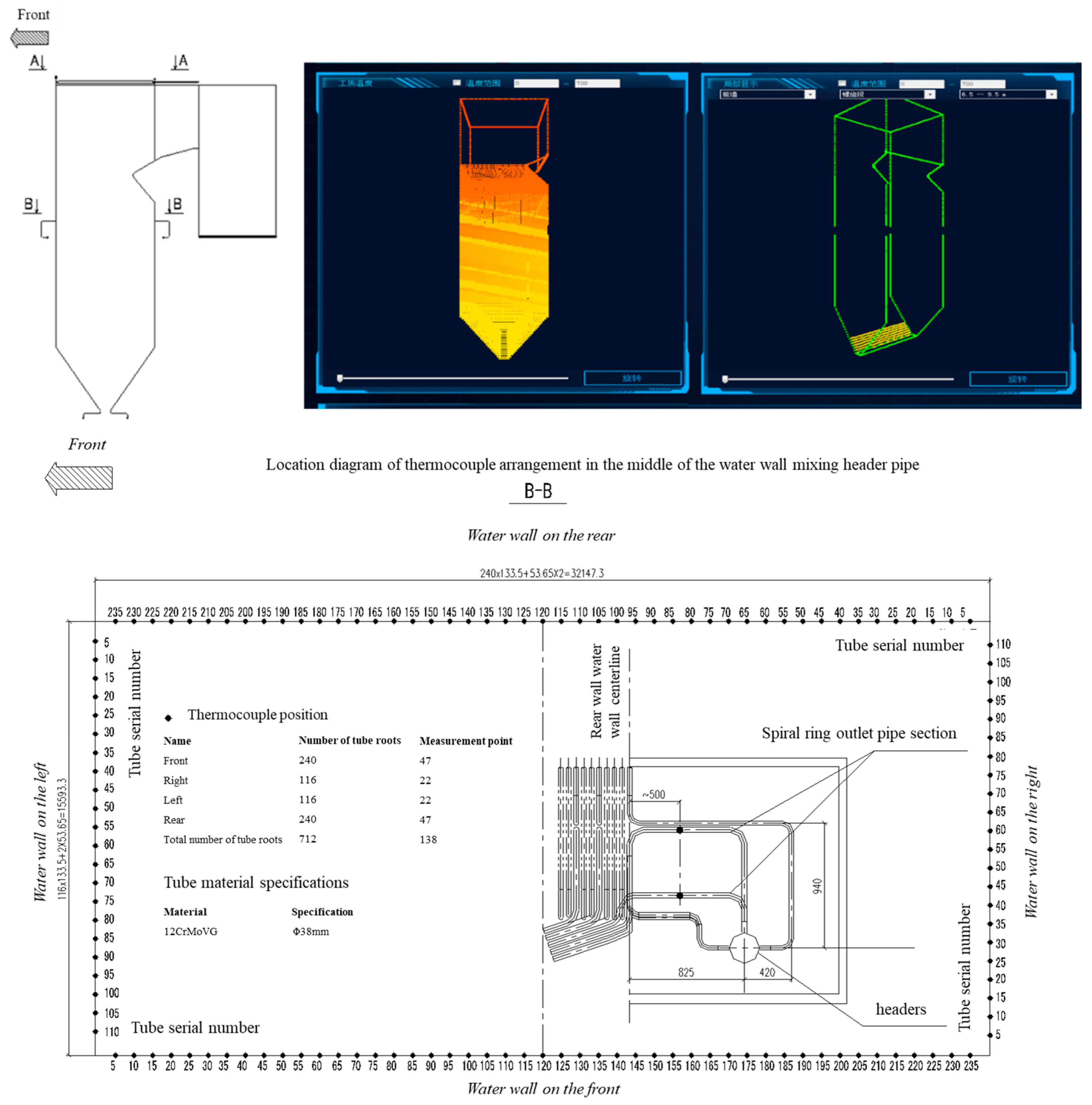
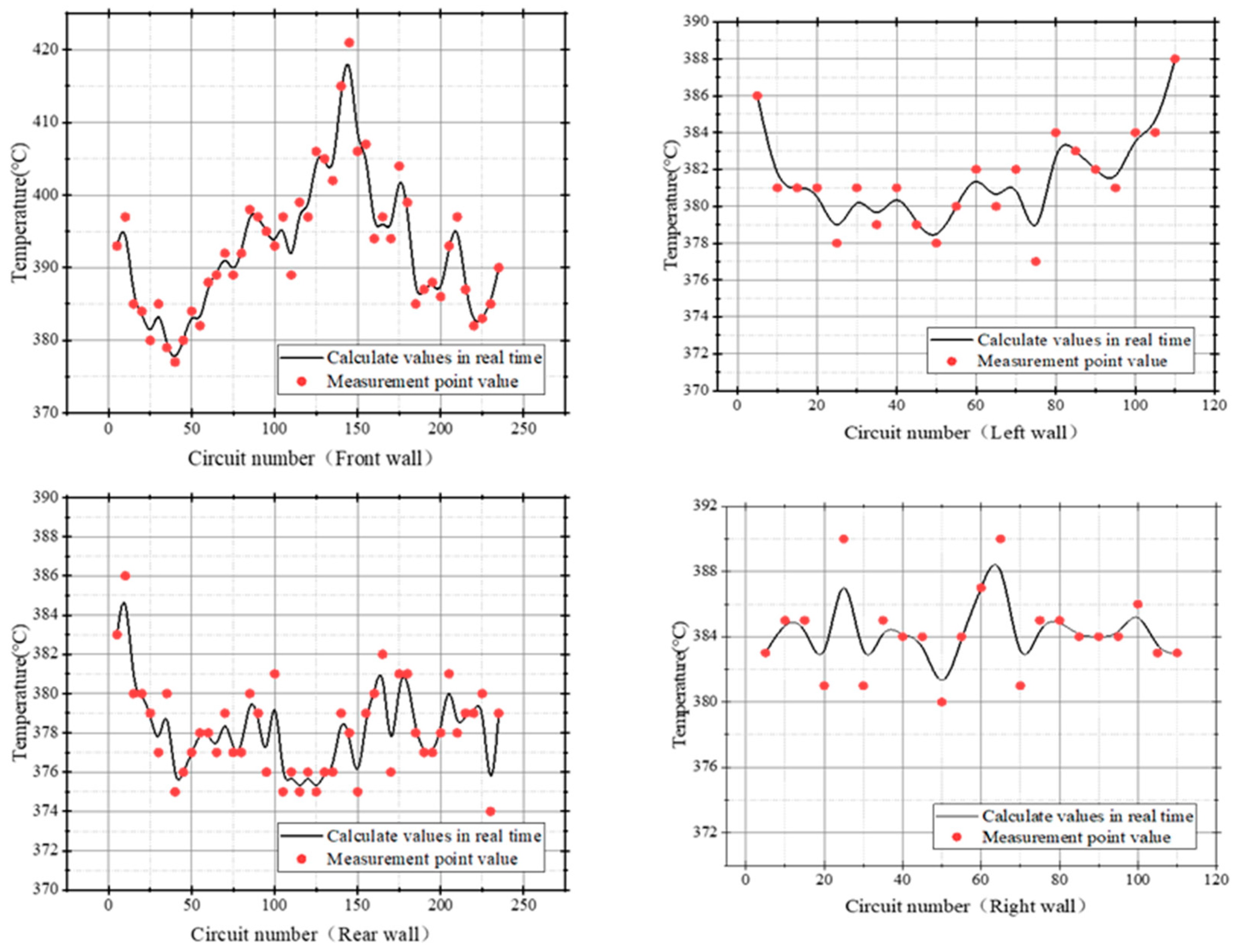
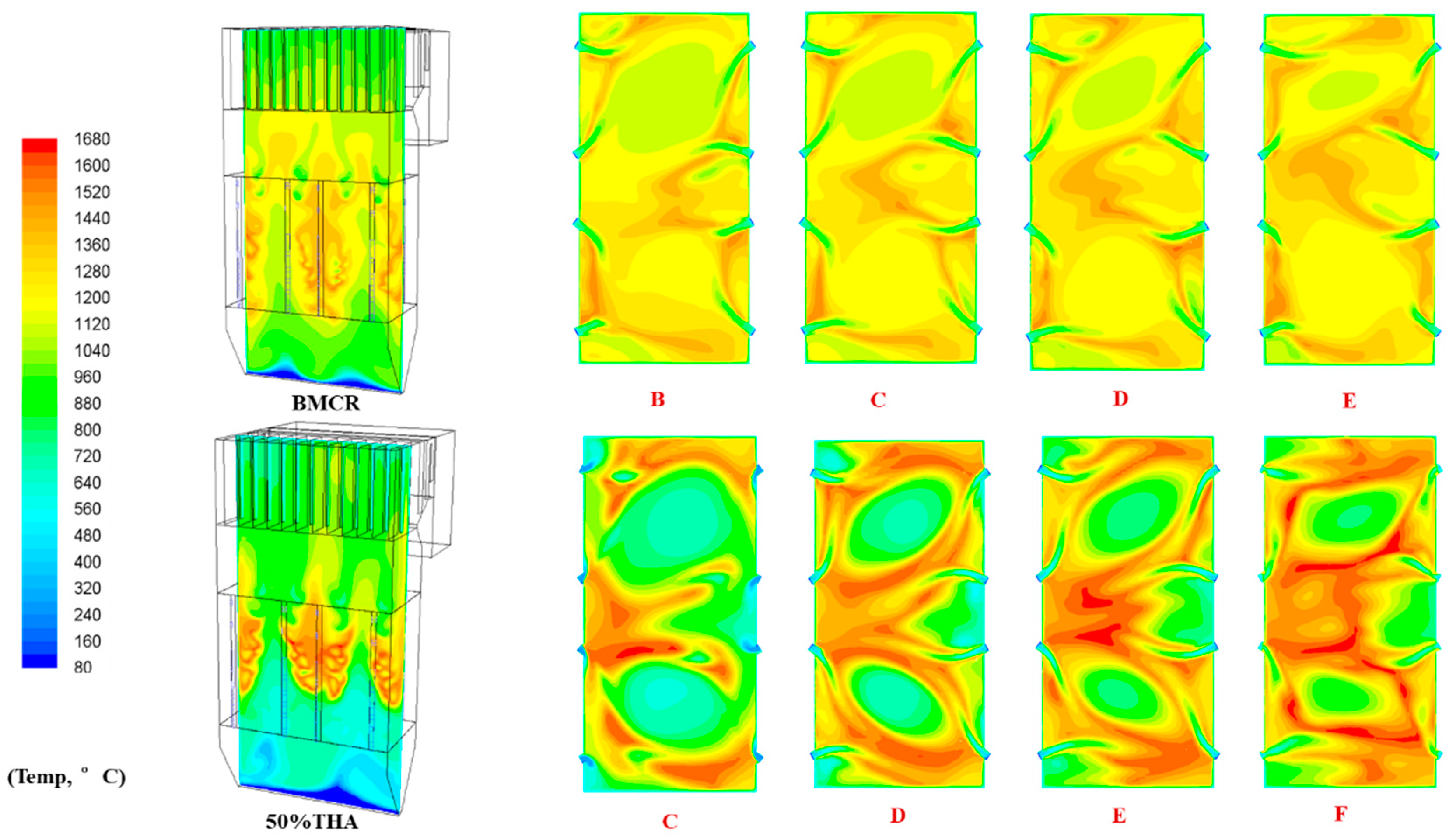
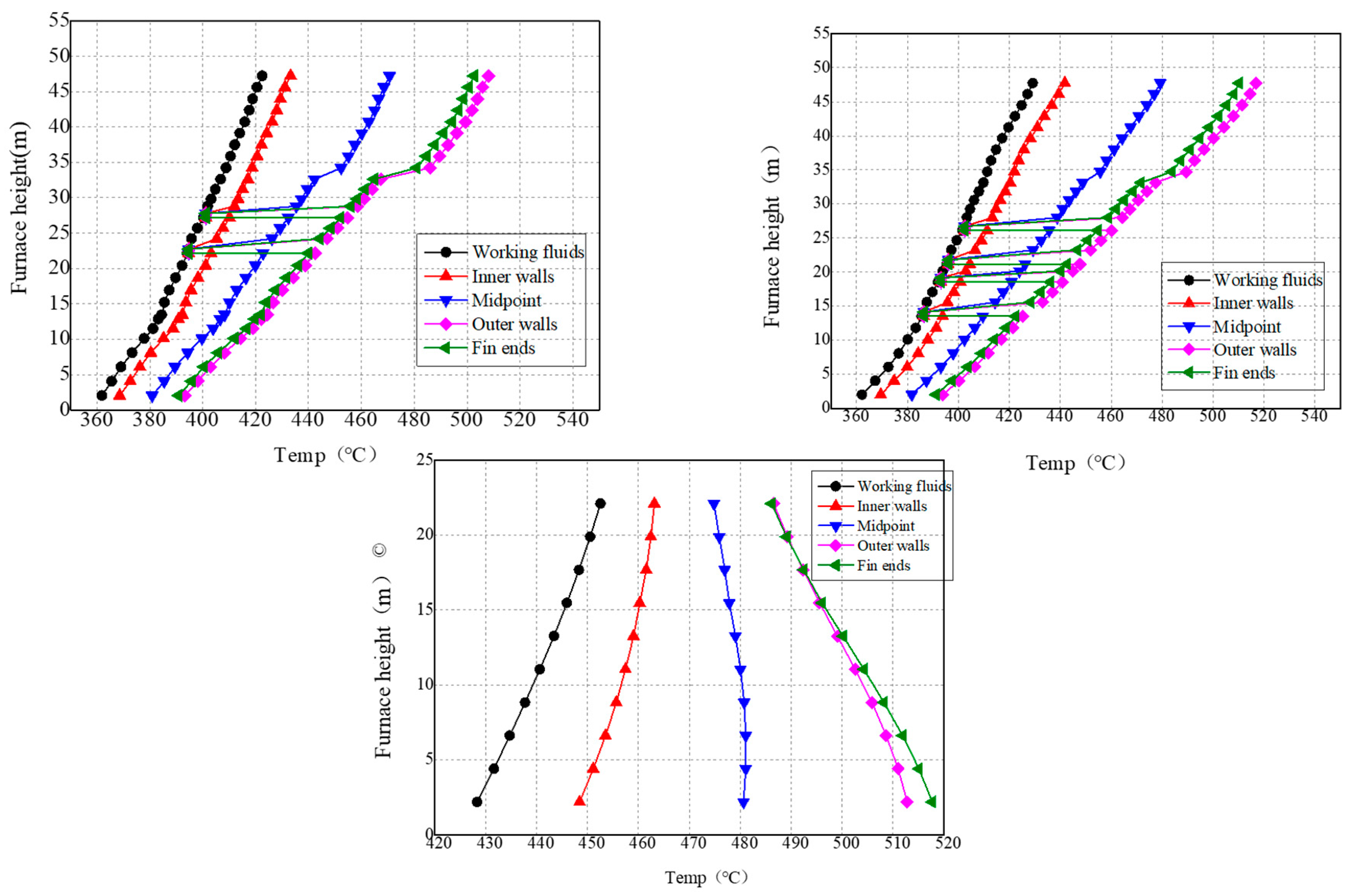
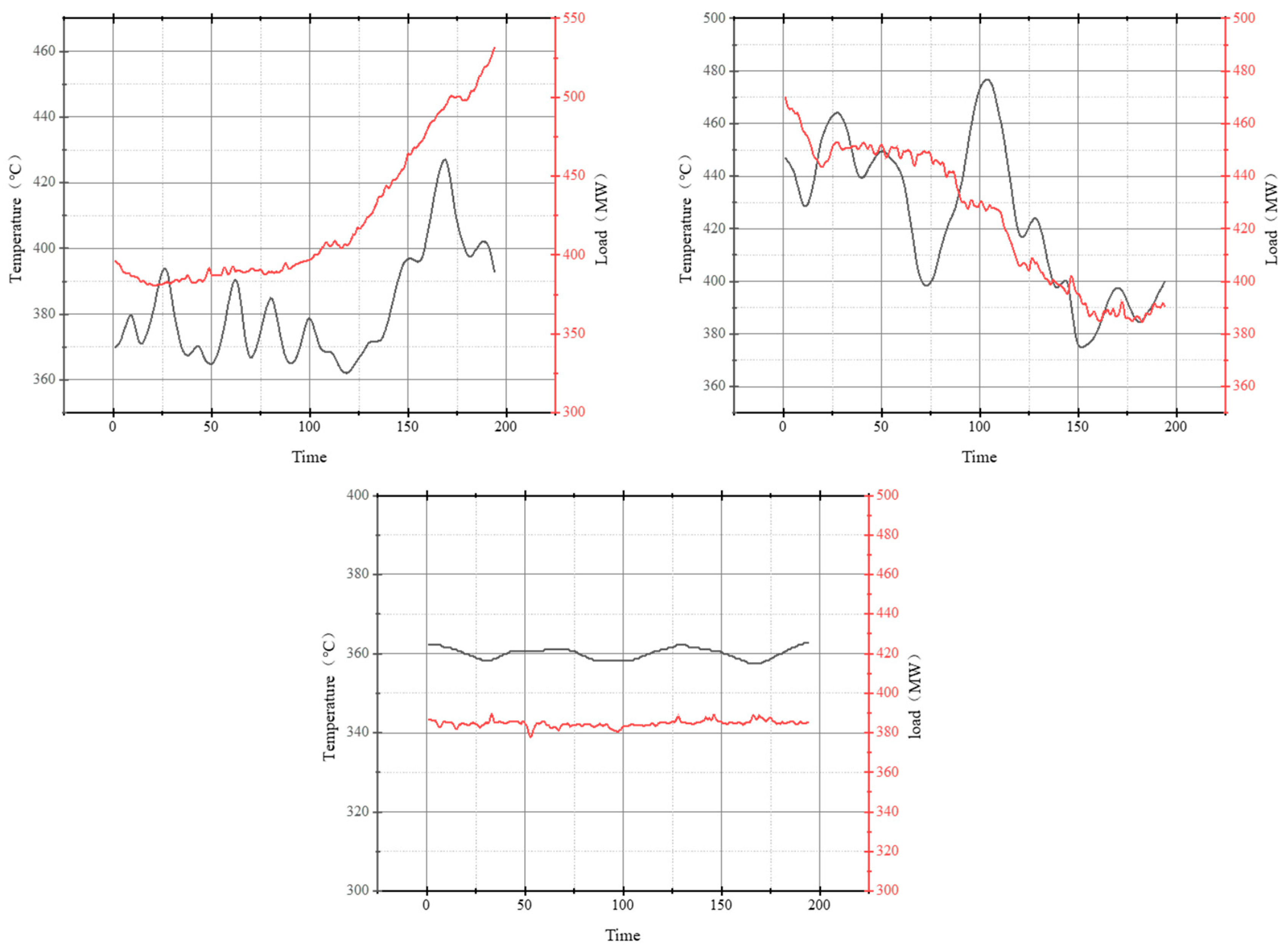
| Name | Unit | BMCR | BRL |
|---|---|---|---|
| Total coal burned | t/h | 406.6 | 397.3 |
| Coal mills | ABCDE | ABCDE | |
| Excess air coefficient | 1.15 | 1.15 | |
| Total airflow | t/h | 321 | 313 |
| Primary wind temperature | °C | 85 | 85 |
| Secondary wind temperature | °C | 344 | 344 |
| Primary wind rate | % | 21 | 21 |
| Burnout wind rate | % | 26.7 | 26.7 |
| Name | Unit | Design Coal Types | Check Coal Types |
|---|---|---|---|
| Car | % | 53.41 | 52.92 |
| Har | % | 3.16 | 2.56 |
| Oar | % | 6.21 | 4.7 |
| Nar | % | 0.65 | 0.6 |
| Sar | % | 1.2 | 1.3 |
| Aar | % | 29.32 | 31.5 |
| Mar | % | 6.05 | 6.42 |
| Mad | % | 2.11 | 2.00 |
| Vdaf | % | 32.8 | 30.81 |
| Qnet,ar | MJ/kg | 20.020 | 19.250 |
| R90 | % | 16 | |
| n | 1 | ||
| x | y | z | Heat-Flux |
|---|---|---|---|
| 16.9867 | 52.321964 | −7.779201 | 151.89 |
| 16.9867 | 52.022541 | −7.779201 | 154.32 |
| 16.686451 | 52.022327 | −7.779201 | 158.74 |
| 16.686255 | 52.321842 | −7.779201 | 156.23 |
| 16.9867 | 51.723125 | −7.779201 | 156.54 |
| 16.686634 | 51.722847 | −7.779201 | 161.06 |
| 16.9867 | 51.423706 | −7.779201 | 158.51 |
| 16.686804 | 51.423409 | −7.779201 | 163.20 |
| 16.9867 | 51.124287 | −7.779201 | 160.42 |
| 16.686951 | 51.124001 | −7.779201 | 165.25 |
| 16.9867 | 52.321964 | −7.779201 | 162.29 |
| 16.9867 | 52.022541 | −7.779201 | 167.21 |
| …… | …… | …… | …… |
| Name | Unit | Value |
|---|---|---|
| One wind speed | m/s | 25 |
| Primary wind temperature | °C | 85 |
| Secondary wind speed | m/s | 46 |
| Secondary wind temperature | °C | 344 |
| Total coal burned | t/h | 406 |
| BMCR | |||||
|---|---|---|---|---|---|
| Name | SST | FGT | SH | RH | ECO |
| Unit | °C | °C | °C | °C | °C |
| Operating Value | 1343 | 1006 | 605 | 613 | 333 |
| Simulation Value | 1340 | 1003 | 605 | 613 | 333 |
Disclaimer/Publisher’s Note: The statements, opinions and data contained in all publications are solely those of the individual author(s) and contributor(s) and not of MDPI and/or the editor(s). MDPI and/or the editor(s) disclaim responsibility for any injury to people or property resulting from any ideas, methods, instructions or products referred to in the content. |
© 2023 by the authors. Licensee MDPI, Basel, Switzerland. This article is an open access article distributed under the terms and conditions of the Creative Commons Attribution (CC BY) license (https://creativecommons.org/licenses/by/4.0/).
Share and Cite
Guo, X.; Zhao, G.; Zhang, Z.; Feng, D.; Wang, Y.; Zhang, Z. A Real-Time Calculation Method to Improve Boiler Safety in Deep Peak Shaving Cases. Energies 2023, 16, 4928. https://doi.org/10.3390/en16134928
Guo X, Zhao G, Zhang Z, Feng D, Wang Y, Zhang Z. A Real-Time Calculation Method to Improve Boiler Safety in Deep Peak Shaving Cases. Energies. 2023; 16(13):4928. https://doi.org/10.3390/en16134928
Chicago/Turabian StyleGuo, Xin, Guangbo Zhao, Zhecheng Zhang, Dongdong Feng, Yongjie Wang, and Zhengshun Zhang. 2023. "A Real-Time Calculation Method to Improve Boiler Safety in Deep Peak Shaving Cases" Energies 16, no. 13: 4928. https://doi.org/10.3390/en16134928
APA StyleGuo, X., Zhao, G., Zhang, Z., Feng, D., Wang, Y., & Zhang, Z. (2023). A Real-Time Calculation Method to Improve Boiler Safety in Deep Peak Shaving Cases. Energies, 16(13), 4928. https://doi.org/10.3390/en16134928








